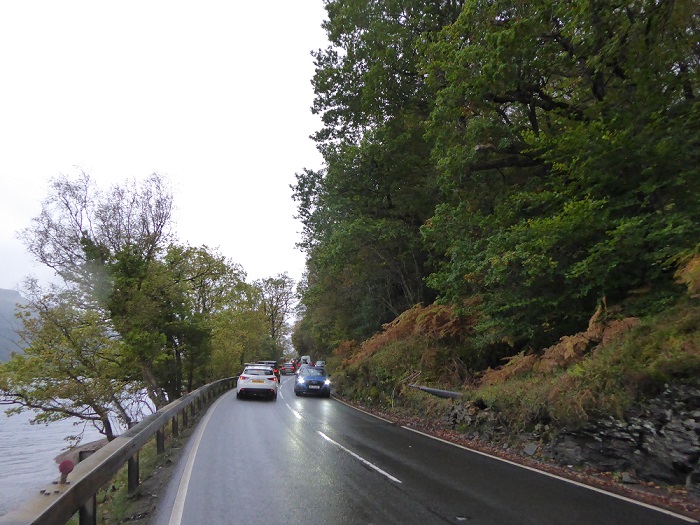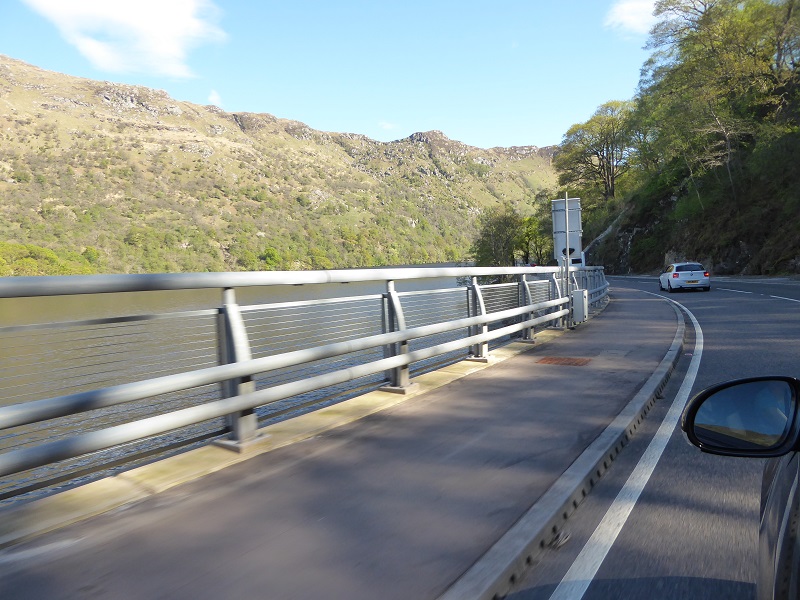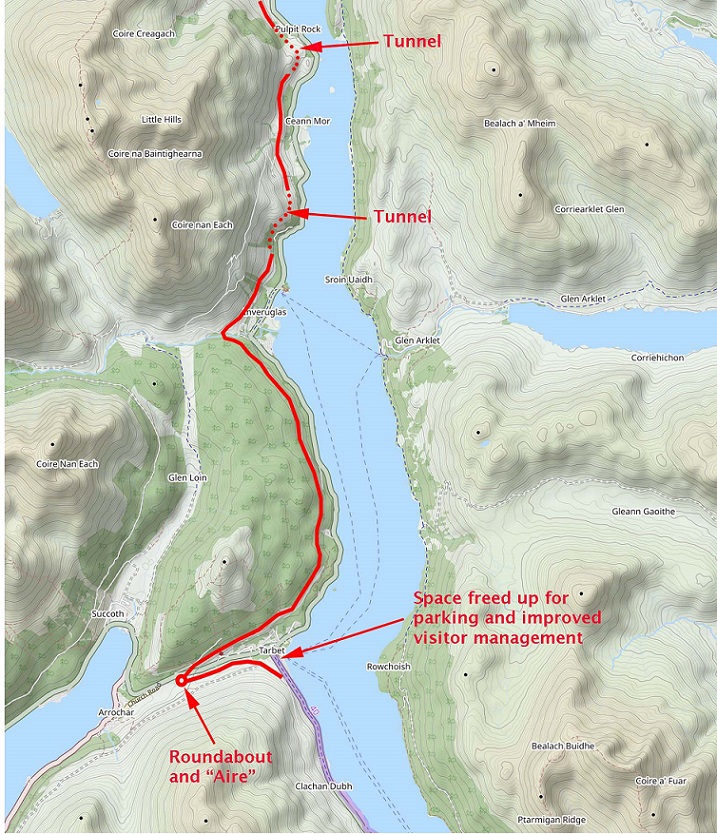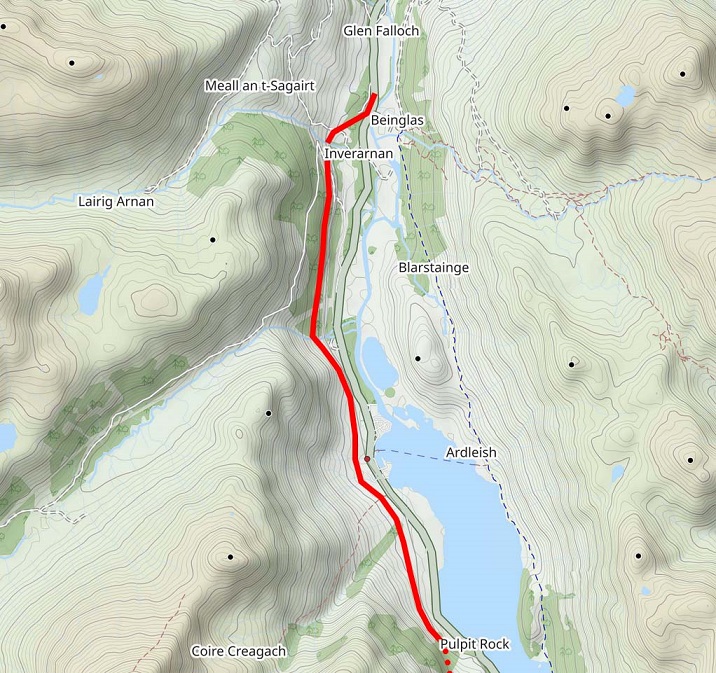
I am writing this post in my capacity as Convener of Helensburgh and District Access Trust (HADAT), a Scottish incorporated charitable trust which seeks to improve countryside access in the Helensburgh and Lomond area. The trust manages the Three Lochs Way Great Trail and for many years has had ambitions to see that route extended further north from its present northern terminus at Inveruglas as far up as Inverarnan, where it could link with The West Highland Way.
At the start of October a consultation was launched on Transport Scotland’s proposals to upgrade the A82 (see here) which is supported by an online interactive Story Map including a fly-through visualisation of the proposed scheme. There is an online survey (see here) for the public to respond which is open until 19th November. It is focussed on asking people about how to improve travel times rather than the impact of the proposals on the natural environment and landscape.
Helensburgh and District Access Trust’s concerns about the proposals
Having examined the online information on the A82 upgrade from Jacobs/Fairhurst, HADAT trustees are of the view that the proposals are fundamentally flawed and do not represent the best available solution.
The upgrade of the A82 between Tarbet and Inverarnan is long overdue, but considering its central position in Scotland’s premier National Park as well as the concomitant scenic, recreational and ecological importance of this beautiful northern stretch of Loch Lomond, we believe the upgrading of this road offers a tremendous opportunity to address a whole host of important related issues, but the proposed scheme doesn’t do any of that. Here are our reasons for saying so.
The upgrade will essentially follow the line of the existing road which hugs the shoreline, so continuing the noise and disturbance which has long damaged this sensitive area of great ecological significance, scenic beauty and importance for recreation.
The ironing out of bends will involve the removal of many areas of irreplaceable Atlantic oak woodland – a staggeringly insensitive and short-sighted proposal, especially so at this time when the UN COP on the global climate crisis has come to Scotland and also especially so, as this is a stunningly beautiful area at the very core of the National Park. It is completely at odds with everything we know about the importance of preserving such scarce remnants of Atlantic Rain Forest.
Viaducts across the bays bring the road into even closer proximity to the loch and will ruin the character of the shoreline in the bays that they cross. In the previous upgrade works south of Tarbet, which were completed some decades ago, there are several long sections where the new road was essentially built right on the shoreline, completely obliterating its character and destroying important freshwater littoral habitat. It seems that in a number of areas the current proposals for the area north of Tarbet involve a very similar approach which is both puzzling and regrettable, particularly given the National Park status enjoyed by the area now.

The new road will be much faster than before and being close to the shore, noise from the traffic will be even louder and will be a constant intrusion for surrounding wildlife as well as for people trying to enjoy Loch Lomond along the shore or out on the water. Sound travels very efficiently along the interface between water and the atmosphere, so West Highland Way walkers half a mile away on the opposite bank will also have their experience of the loch spoiled by the constant traffic racket.
Helensburgh and District Access Trust’s proposed alternative route
A better solution would have been to pull the road back from the water and where rock spurs exist, put it through a tunnel rather than having open cuttings backed by rock walls which reflect sound out over the water. Of course the presence of the West Highland railway line makes such a solution difficult, never mind the damage which would be done to the oakwoods. The route should therefore be above the railway line where the existing land use is dominated either by commercial conifer woodland or poor quality rough grazing, both of which are severely degraded habitats of limited ecological value. Tunnels would be required at rock spurs or where slopes are particularly steep as they are above Creag a Phuirt and Pulpit Rock where some very steep and craggy ground is clothed in a substantial area of ancient birch/oak woodland.
The key advantages of our proposal are:
- It would spare the biodiverse oak woods below which are to be sacrificed under the present proposal.
- A second benefit of this approach would be that the old road could continue to carry traffic during the construction period and afterwards of course it would be available in its entirety as a safe walking and cycling route as well as for access to lochside farms and properties and the Sloy power station.
- Third, it would allow our organisation to realise its long held ambition to extend the Three Lochs Way Great Trail further north to link with the West Highland way at Inverarnan, so facilitating a Round Loch Lomond walking route which would enhance the recreation and tourism potential of the area.
- Engineering issues would generally be simpler as the route would be straighter with fewer problems accommodating existing buildings and infrastructure.
- Ardlui would be bypassed.
- A sixth benefit would be for the road users themselves as, being elevated, the road would afford stunning views across and up and down the loch. There would also be ample space for scenic lay-bys. We recommend that the consultants visit the A8003 between Glendaruel and Tighnabruaich to fully appreciate the potential of the benefit being described here. The new road would be a scenic “tour de force” and would quickly develop a reputation as one of Scotland’s “must do” tourism experiences.
- There would also be opportunities to landscape the margins of the new road with plantings of native woodland species thereby doing something to improve the impoverished biodiversity in that area.

The obvious way to make the southern connection to the existing road south of Tarbet would be with a roundabout and the obvious place to do that is on the low lying vacant land in the centre of the Tarbet – Arrochar isthmus, immediately south west of the point where the railway crosses the A83. A high embankment carries the railway across the valley floor here so there is good potential to bring the new road under the railway. At a stroke this would free up badly needed space for parking and improved visitor management arrangements at Tarbet Bay, while at the same time bringing a huge benefit to the residents of Tarbet, as it would mean the heavy traffic would completely bypass the village, resolving long standing quality of life, health and road safety issues, including the problem of the dangerous pedestrian footway by the A83 where it passes through the narrow railway bridge.
Toileting by road users is a serious issue along the A82 and there is a crying need for some kind of “Aire” where cars and more importantly, HGVs and buses can easily and safely pull off the road and park so that drivers and passengers can make use of services. This would be an excellent location for something like that. It is a brown field site having previously been used as a refuse dump, yet it has a wonderful view of the Cobbler and has great commercial potential. Developments along these lines would do much to address some of the blight that Tarbet and existing A82 lay-bys have had to suffer for far too long.

At the northern end of the upgrade area (top diagram), the valley of the Alt Arnan provides an opportunity to bring the road back in below the railway again and down onto the Glen Falloch valley floor where there is plenty of space to make a connection with the existing road just north of Inverarnan Farm.
Splendid proposal – much more ambitious in its regard for the environment and the biodiversity of the shoreline and the area, and much more ambitious in the promotion of Scottish tourism sustainably into the future.
If planners really wanted to see how these environmentally sensitive road upgrades can be built without trashing the surroundings they have only to look at highways in Norway..where tunnels are commonplace..or Switzerland where autobahns have been put under cities ( Neuchatel) and alongside areas of outstanding natural scenery.
The stretch of Autobahn that today lies south of Zurich ( CH) runs alongside the Walenzee .https://www.google.com/maps/@47.1215251,9.1970244,12.12z for the past 20 years it has become hidden: employing a series of tunnels. ( These took over 7 years to bore) But the old lake side road is still there and was in use as one carriageway until the second tunnel was completed – today it is a scenic route for walkers and local traffic. It is beyond time these planners took advice from engineers of other nations.
( Use of Tarbet – Inverarnen is probably in my DNA now ..My father died over 50 years ago now . If as centanarian he was still alive now he would still recognise the collapsed stone walls that have always lined too much of it, dangers which we discussed so often.)
The state of this short section of trunk road remains a national disgrace, cutting the west highlands off from efficient transport connection with motorways south from Glasgow. The state of it alone has rerouted parcel traffic to the central west highlands, off up the A9 via Inverness.
But if money is at last to be made available, Scottish ministers should look at “leading the world”. There are standard underground cut and shut and tunnel engineering solutions. Get a home based industry trained up by Norwegian German or Swiss experts to bore tunnels. Build time saving efficient , fuel saving Scottish transport links, not be fobbed off yet again for another generation ..sanctioned to fall back onto ‘same old’ realignment tinkering , ‘same old’ patch, titivate and repair.
I support the idea of boring a tunnel to solve this long-running issue on the A82 beside Loch Lomond. However, if the powers that be say it would be too expensive, then they might want to consider a variation on the tunnel proposal. A smaller tunnel could be used by northbound traffic, leaving the existing lochside road for southbound only traffic. I realise that this would keep that existing section of lochside road in use, but by making it one-way it should be safer and provide space for segregated two-way walking and cycling. Meanwhile, the smaller tunnel should be cheaper to construct and also be safer on account of only having one-way traffic.
Does anyone know if this alternative idea has ever been considered?
I have entered feedback on the current proposals and suggested a seperate higher route for the advantages as per this post. I fear that while this govt can blow hundreds of millions on things like failed ferries and compensation for illegal Rangers prosecutions their track record on major infrastructure does not give me any confidence that they will adopt this scheme.
For example the billion or thereabouts on the new Forth crossing which deliberately designed in traffic congestion to push the masses onto public transport.
“. The project was not intended to increase the capacity of the route for traffic. The
business case states that increased demand for travel across the Forth will need to
be met by public transport. This is in line with the Scottish Government’s objective
to maintain traffic volumes and increase the use of sustainable transport””
https://www.audit-scotland.gov.uk/uploads/docs/report/2018/nr_180802_forth_crossing.pdf
The “Powers that Be” do say a new higher level corridor will be too expensive but I am pretty sure that they are wrong. If it were now assessed on the basis of the actual cost of the Pulpit Rock viaduct, the extra width now required for the road and a cycleway built to current design advice, the physical cost of the shoreside development will probably double. When you take into consideration the cost (over the high level route) of the disruption caused, of the noise pollution and of the environmental destruction, coupled with the minimal cost of capital at the current time, I think the answer will be a high level route that will still be sensible in fifty years. This will correspond to what the public actually believe to be the right solution.
Geoff is of course quite correct. Every single time the “Powers that be” decide to fiddle with the collapsing old ‘cart track’ down the side of the Loch towards Tarbet, this work will close the road. Everytime there is the smallest traffic incident tree felling needed or collision the road is also closed. For decades now this has led to 50 mile diversions and further total uncertainty for businesses and individuals who depend on that road to get from the central west highlands to Glasgow…to the airport..to Scotland’s largest Hospital …or to send goods within the rest of the UK by air, road or rail. To even consider that modifying the existing road yet again is any sort of a kind solution for those that need to use it, displays a very blinkered mindset. Another decade of constant roadside works as realignment phases progress? This would subject the population of North Argyll, Lochaber and beyond to years of further uncertainty expense and disruption , all without any compensation. This is bonkers.
It is clear the ‘patch and repair’ mindset “slate” must be wiped clean.
A new route must be selected….under compulsory purchase terms if needs be…along which a fresh road may be completed without affecting essential trade and other road users. (This is how the Aberdeen bypass and the new Forth bridge were both able to be constructed after all ) It is so damning of the present Scottish Government that whenever some infrastructure is needed for the central belt, or more recently for connections towards the North and NE of Scotland, this happens without much debate.
Can it really be that the present First Minister and her MSP colleagues are now unfamiliar with the Tarbet – Inverarnen tittivated cart track at all ? Perhaps none of them dare travel by road just 30 miles north of the First Minster’s own constituency by road, for fear of being seen there, held up or diverted? A suspicion about selective vision towards this lifeline route lingers.
A very commendable proposal from HADAT.
While the Transport Scotland scheme does include a segregated footpath / cycleway. It looks so close to the upgraded road that I can’t image it being very pleasant to use.
However I think there is another, overlooked option, that would significantly enhance the environment of the area – close the A82 to through traffic (other than public transport) between Tarbet and Crianlarich.
The diversion routes on the story map show extra journey times of 5 and 18 minutes for Tarbet to Oban and Glasgow to Tyndrum respectively. These routes seem much more easily upgradable.
While this would no doubt cause significant disruption to local transport, it would at least align with the stated aims National Park Authority.
https://www.lochlomond-trossachs.org/park-authority/what-we-do/our-aims-values/
I’ve seen pedestrian and cycle tunnels in Europe motorway tunnels in Stockholm through Granite, Norway creating a tunnel for cruise liners. Only in Scotland do we find that we are too backward and lacking the required engineering skills, the pathetic proposals for the rest and be thankful are proof. Why can’t we bring contractors from abroad?